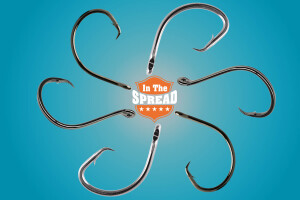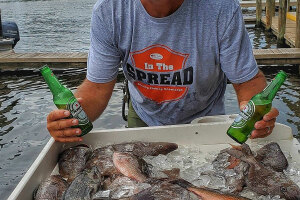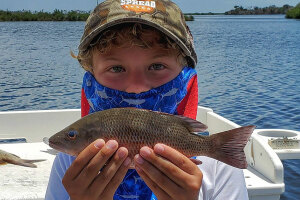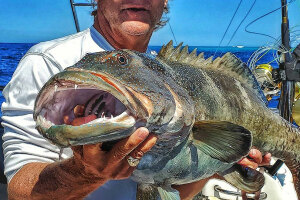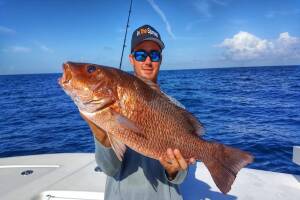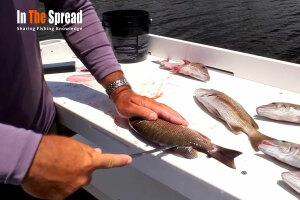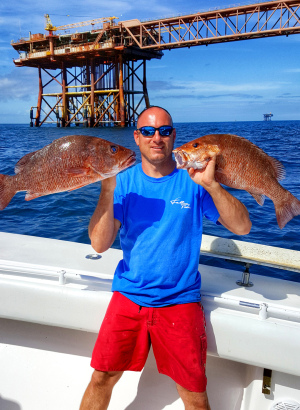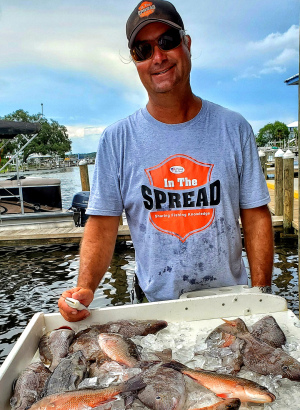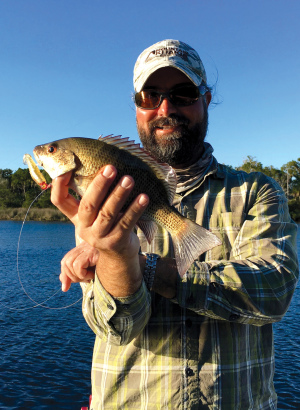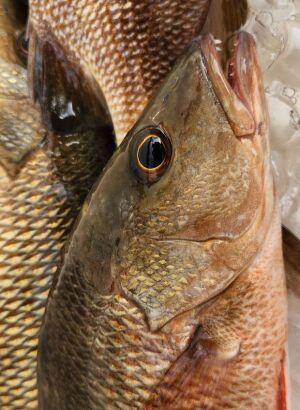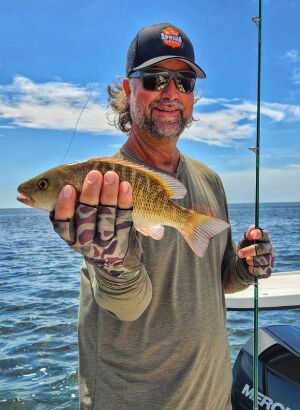Mangrove snapper test every angler's skill with their wariness and selective feeding. This comprehensive resource covers their biology, habitat preferences, feeding behavior, and proven fishing techniques. Learn the best baits, rigs, and tactics for consistently catching these prized inshore gamefish in various conditions.
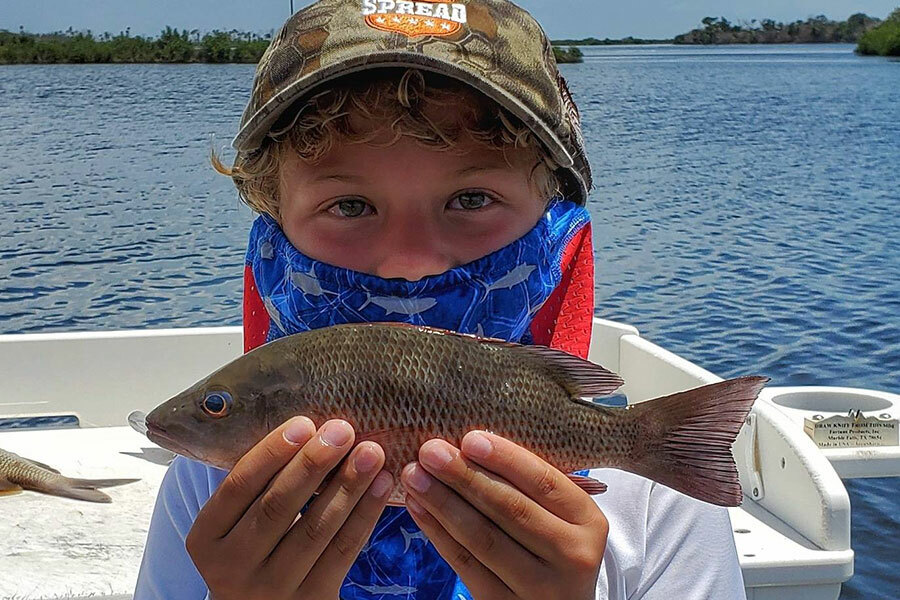
Mangrove Snapper - Smarter Fishing
Mangrove snapper are one of the most popular inshore gamefish along the Gulf Coast and southern Atlantic. These savvy predators offer excellent table fare and challenging fights on light tackle. Here's everything you need to know to consistently catch mangrove snapper.
What Makes Mangrove Snapper Aggressive Predators?
This is an aggressive predatory fish and will hunt and eat other fish in order to survive. They are opportunistic feeders and will consume a variety of prey, including small fish, crustaceans, and mollusks. Mangrove snappers are generally solitary hunters and will locate prey using their keen senses, including their sense of smell, vision, and lateral line system. Once they have located their prey, they will use their sharp teeth and powerful jaws to capture and consume it. Some mangrove snappers have been known to hunt in groups or schools, using coordinated attacks to catch and consume larger prey.

Where Do Mangrove Snapper Live?
Mangrove snapper are found in a variety of habitats, including mangrove forests, coral reefs, and estuaries. They are typically found in shallow, inshore waters and are often found near the bottom of the water column.
Mangrove forests are a type of coastal wetland habitat found in tropical and subtropical regions around the world. They are characterized by their dense stands of salt-tolerant trees and shrubs, which are adapted to living in the high-saline conditions found in these areas. Mangrove forests provide important habitat for a wide variety of marine and terrestrial species, including the mangrove snapper.
Coral reefs are another important habitat for mangrove snapper. Coral reefs are underwater structures formed by the accumulation of coral skeletons and other calcium carbonate materials. They are found in tropical and subtropical waters around the world and are home to a diverse array of marine life, including fish, invertebrates, and plants.
Estuaries are areas where freshwater from rivers and streams mixes with saltwater from the ocean. These areas are often highly productive and support a wide variety of plant and animal life, including mangrove snapper. Estuaries provide important nursery habitat for many species of fish, including mangrove snapper, and are also important feeding and breeding areas.
Mangrove snapper are generally found in shallow waters, typically less than 30 meters (100 feet) deep. They are most commonly found in areas with a rocky or coral bottom, where they can find shelter and ambush their prey. They are also found in areas with a muddy or sandy bottom, and may be found around structures such as pilings or wrecks. Overall, mangrove snapper are found in a wide range of inshore marine habitats, from mangrove forests and coral reefs to estuaries and seagrass beds.
The Fundamentals of Mangrove Snapper Behavior
How Do Mangrove Snapper Behave?
Mangrove snapper are solitary predators that hunt and feed on a variety of prey, including small fish, crustaceans, and mollusks. They are opportunistic feeders and will consume whatever prey is available to them. These fish are generally found in shallow, inshore waters and are often found near the bottom.
Grovers are relatively sedentary fish and tend to remain in a small home range throughout their lives. They are generally found in areas with rocky or coral bottoms, where they can find shelter and ambush their prey. However, they may also be found in areas with a muddy or sandy bottom, and may be found around structures such as pilings or wrecks.
They are generally non-migratory fish species, but some populations may exhibit small-scale movements in response to changes in environmental conditions, such as temperature and salinity.
Mangrove snapper are protogynous hermaphrodites, meaning that they are born female and can change sex to male as they mature. The timing of this sex change varies among individuals and may be influenced by a variety of factors, including size, age, and social conditions.
This fish is an important species in many marine ecosystems and play a role in the food web as both predators and prey. They are an important food source for larger predatory species, such as sharks and larger fish, and are also an important prey species for humans, who harvest them for food and sport fishing. In addition to their ecological importance, mangrove snapper are also an important economic resource, with recreational and commercial fisheries targeting the species in many parts of their range.
When Do Mangrove Snapper Mature?
The process of sex change in mangrove snapper typically begins at a length of about 20 cm (8 inches) and a weight of about 0.5 kg (1 pound). As the fish grows and matures, the testes will begin to develop and the ovaries will regress. The process of sex change is usually complete by the time the fish reaches a length of about 25-30 cm (10-12 inches) and a weight of about 1 kg (2 pounds).
Mangrove snapper are thought to have a lifespan of about 8-10 years, although some individuals may live longer. They reach sexual maturity at a size of about 20 cm (8 inches) and a weight of about 0.5 kg (1 pound), and will reproduce throughout their lives.
How Do Mangrove Snapper Reproduce?
It is thought that mangrove snapper reproduce throughout the year, with peak spawning occurring in the summer months. They are thought to have multiple spawning events throughout the year, and may have several different mating partners over the course of their lifetimes.
Mangrove snapper are oviparous, meaning that they lay eggs that hatch outside of the female's body. The eggs are typically laid in shallow, sheltered areas, such as mangrove forests or coral reefs. After being laid, the eggs are fertilized by the male and left to hatch on their own. The eggs are typically guarded by the male until they hatch, after which the larvae are left to fend for themselves.
Little is known about the specific breeding habits of mangrove snapper, and more research is needed to fully understand their reproductive biology.
Do Mangrove Snapper Migrate?
Grovers are generally non-migratory fish and tend to remain in a small home range throughout their lives. However, some populations of mangrove snapper may exhibit small-scale movements in response to changes in environmental conditions, such as temperature and salinity. These movements may be related to breeding behavior or to changes in the availability of food resources.
It is thought that this snapper reproduces throughout the year, with peak spawning occurring in the summer months. Some populations of mangrove snapper may exhibit small-scale movements during the breeding season in order to locate suitable spawning habitats or to find mates. These movements may be related to the availability of suitable habitats, such as mangrove forests or coral reefs, or to changes in water temperature or salinity.
Overall, mangrove snapper are generally non-migratory and tend to remain in a small home range throughout their lives. However, small-scale movements in response to changes in environmental conditions may occur in some populations.
What Do Mangrove Snapper Eat?
This is a savagely predatory fish that hunts and feeds on a variety of prey, including small fish, crustaceans, and mollusks. They are opportunistic feeders and will consume whatever prey is available to them.
Mangrove snapper are generally found in shallow, inshore waters and are often found near the bottom of the water column, where they can hide from predators and ambush their prey. They use their keen senses, including their sense of smell, vision, and lateral line system, to locate prey and capture it using their sharp teeth and powerful jaws.
Mangrove snapper are generally solitary hunters, although some populations have been known to hunt in groups or schools, using coordinated attacks to catch and consume larger prey. They are thought to feed mostly during the day, although they may also feed at night.
In addition to small fish, crustaceans, and mollusks, mangrove snapper may also consume other invertebrates, such as worms and insect larvae, as well as algae and other plant material. Their diet is highly variable and will depend on the availability of prey in their environment.
Why Are Mangrove Snapper So Fun to Catch?
Mangrove snapper are considered to be excellent game fish due to their excellent fighting abilities and delicious flesh. They have strong, powerful bodies and are known to put up a good fight when hooked, making for an exciting and challenging fishing experience.
There are several reasons why mangrove snapper fishing is considered to be so much fun:
- Challenge: Known for their excellent fighting abilities, and catching one can be a real challenge. They have strong, powerful bodies and are known to put up a good fight when hooked, making for an exciting and challenging fishing experience.
- Versatility: Mangrove snapper can be caught using a variety of different techniques, including jigging, live bait fishing, and bottom fishing. This versatility makes them a popular target for anglers of all skill levels, from beginners to experienced fishermen.
- Delicious flesh: They are highly prized for their delicate, flavorful flesh, which is considered to be some of the best-tasting of all the snapper species.
- Abundance: Widely distributed throughout the tropical and subtropical waters of the western Atlantic Ocean, and can be found in a variety of inshore habitats, including mangrove forests, coral reefs, and estuaries. This abundance means that anglers have a good chance of finding and catching mangrove snapper in many different locations.
Mangrove snapper fishing is considered to be a lot of fun because it offers a challenging and exciting fishing experience, as well as the opportunity to catch a delicious and highly prized fish.
What Artificial Lures Work for Mangrove Snapper?
There are a variety of artificial lures that can be effective for catching mangrove snapper, including jigs, soft plastics, and hard baits. Some specific examples of artificial lures that may be effective for mangrove snapper include:
- Jigs: Jigs are weighted lures that are designed to be fished near the bottom of the water column. They can be effective for catching mangrove snapper, especially when fished in areas with a rocky or coral bottom.
- Soft plastics: Soft plastics, such as grubs, worms, and curly tails, can be effective for catching mangrove snapper. They can be fished on a jighead or rigged on a hook and can be fished near the bottom or on the surface.
- Hard baits: Hard baits, such as crankbaits and swimbaits, can be effective for catching mangrove snapper when fished near the bottom or on the surface. They can be particularly effective when fished in areas with a lot of structure, such as around pilings or wrecks.
It is important to match the size and type of lure to the size and type of prey that mangrove snapper are feeding on in a given area. Using the wrong size or type of lure may result in fewer bites and fewer fish caught.
Why Use Artificial Lures for Mangrove Snapper?
There are several benefits to using artificial lures for catching mangrove snapper:
- Longevity: Artificial lures are generally more durable and long-lasting than natural baits, which means they can be used multiple times without needing to be replaced. This can be more cost-effective and convenient for anglers, especially those who are targeting mangrove snapper over an extended period of time.
- Versatility: Artificial lures can be fished in a variety of different ways and can be effective for catching a wide range snapper species. This versatility makes them a good choice for anglers who are targeting a variety of different species or who are fishing in different types of water.
- Reduced waste: Natural baits, such as shrimp and live baitfish, can be expensive, problematic to catch and may produce a lot of waste, especially if they are not used effectively. Artificial lures, on the other hand, produce minimal waste and do not require the use of live bait, which can be more environmentally friendly.
- Consistency: Artificial lures can be fished consistently and at a specific depth or speed, which can be beneficial for targeting mangrove snapper. This can help anglers to more effectively target and catch mangrove snapper, especially in areas where the fish may be finicky or difficult to catch.
Artificial lures really do offer a number of benefits.
What's the Best Live Bait for Mangrove Snapper?
There are a variety of live baits that can be effective for catching mangrove snapper, including small fish, crustaceans, and mollusks. Some specific examples of live baits that may be effective for mangrove snapper include:
- Small fish: Small fish, such as minnows, herring, and sardines, can be effective live baits for catching mangrove snapper. These baits can be fished on a hook or rigged on a jighead and can be fished near the bottom or on the surface.
- Crustaceans: Crustaceans, such as shrimp, crabs, and lobsters, can also be effective live baits for catching mangrove snapper. These baits can be fished on a hook or rigged on a jighead and can be fished near the bottom or on the surface.
- Mollusks: Mollusks, such as clams and mussels, can be effective live baits for catching mangrove snapper. These baits can be fished on a hook or rigged on a jighead and can be fished near the bottom or on the surface.
It is important to match the size and type of live bait to the size and type of prey that mangrove snapper are feeding on in a given area. Using the wrong size or type of live bait may result in fewer bites and fewer fish caught.
Why Use Live Bait for Mangrove Snapper?
There are several benefits to using live bait for catching mangrove snapper:
- Natural appeal: Live bait has a natural, lifelike appearance and movement that can be very appealing to mangrove snapper and other predatory fish. This can make it more effective for catching fish, especially in situations where the fish may be finicky or difficult to catch.
- Realistic scent: Live bait also releases a natural scent that can be attractive. This can help to attract fish to the bait and increase the chances of a bite.
- Live action: Live bait has a natural, lifelike action that can be very appealing to predatory fish. This can help to trigger a bite and increase the chances of catching fish.
- Versatility: Live bait can be fished in a variety of different ways and can be effective for catching a wide range of fish species, not just mangrove snapper. This versatility makes it a good choice for anglers who are targeting a variety of different species or who are fishing in different types of water.
Overall, live bait offers a number of benefits for catching mangrove snapper and other predatory fish. It is a natural, lifelike bait that can be very effective for triggering bites and catching fish.
How Do You Catch Mangrove Snapper?
There are a variety of fishing techniques that can be effective for catching mangrove snapper, including jigging, live bait fishing, and bottom fishing, to name a few.
- Jigging: Jigging involves using a weighted lure, known as a jig, and fishing it near the bottom of the water column. Jigging can be effective for catching mangrove snapper, especially when fished in areas with a rocky or coral bottom. Jigs can be fished using a variety of different techniques, such as vertical jigging, casting and retrieving, and slow trolling.
- Live bait fishing: Live bait fishing involves using a live bait, such as a small fish, crustacean, or mollusk, to catch mangrove snapper. Live bait can be fished on a hook or rigged on a jighead and can be fished near the bottom or on the surface. Live bait fishing can be effective for catching mangrove snapper, especially in areas where the fish are feeding heavily on a specific type of bait.
- Bottom fishing: Bottom fishing involves fishing near the bottom of the water column using a variety of different techniques and baits. Bottom fishing can be effective for catching grovers, especially when fished in areas with a rocky or coral bottom. Techniques such as drifting, still fishing, and baitcasting can all be effective for catching mangrove snapper using bottom fishing techniques.
The best fishing technique will depend on the specific conditions and preferences of the angler. Anglers should consider factors such as the type of water being fished, the type and availability of bait, and the skill level of the angler when selecting a fishing technique for mangrove snapper.
How Do You Chum for Mangrove Snapper?
Mangrove snapper are opportunistic feeders that will generally bite on a variety of baits and lures. When using chum to attract mangrove snapper, you can use a variety of materials, including small fish, shrimp, crabs, and other invertebrates. You can also use a mixture of these materials to create a more attractive and varied chum slick.
It is important to consider the type of chum you use based on the time of year, the location, and the specific needs of the mangrove snapper. For example, in the winter months, mangrove snapper may be more attracted to shrimp or crabs, while in the summer they may be more attracted to small fish or other invertebrates.
In general, the most effective chum for mangrove snapper is fresh and varied, and it is best to use materials that are native to the area where you are fishing. You can also add other attractants, such as scents or oils, to your chum to make it more appealing to the fish.
What Rigs Work Best for Mangrove Snapper?
There are a variety of fishing rigs that can be effective for catching mangrove snapper, including the following:
- Knocker rig: The knocker rig is a popular rig for catching mangrove snapper and other bottom-dwelling fish. It consists of a main line with a weight at the bottom and a hook or jig above the weight. The weight is used to hold the rig in place on the bottom, while the hook or jig is used to attract and catch fish.
- Carolina rig: The Carolina rig is another popular rig for catching mangrove snapper and other bottom-dwelling fish. It consists of a main line with a weight at the bottom and a hook or jig above the weight, with a leader line attached to the hook or jig. The weight is used to hold the rig in place on the bottom, while the hook or jig is used to attract and catch fish.
- Split shot rig: The split shot rig is a simple rig that is effective for catching mangrove snapper and other bottom-dwelling fish. It consists of a main line with a weight at the bottom and a hook above the weight, with a small split shot weight attached to the main line above the hook. The weight is used to hold the rig in place on the bottom, while the hook is used to attract and catch fish.
- Live bait rig: The live bait rig is a popular rig for catching mangrove snapper and other predatory fish using live bait. It consists of a main line with a hook or jig at the end, with a leader line attached to the hook or jig. The hook or jig is used to hold the live bait, which is used to attract and catch fish.
Learn more fishing skills with our powerful learning system of instructional fishing videos: https://inthespread.com
Frequently Asked Questions About Mangrove Snapper
What size hook should I use for mangrove snapper?
Use 1/0 to 3/0 circle hooks for most mangrove snapper fishing. Smaller 1/0 hooks work well for inshore fishing with live shrimp, while 2/0 to 3/0 hooks handle larger baits like pinfish or cut bait. Circle hooks reduce gut-hooking and improve catch-and-release survival.
What depth do mangrove snapper prefer?
Mangrove snapper inhabit depths from 3 feet in backcountry mangroves to over 100 feet on offshore structure. Inshore fish typically hold in 10-30 feet of water around docks, bridges, and oyster bars. Larger mangrove snapper move to deeper reefs and wrecks in 40-100 feet.
What time of day is best for mangrove snapper?
Dawn and dusk produce the most aggressive feeding behavior, though mangrove snapper bite throughout the day. Low-light periods trigger feeding frenzies, especially during moving tides. Night fishing can be excellent around lighted docks and bridges where baitfish congregate.
What pound test line for mangrove snapper?
Use 15-20 lb braided main line with 20-30 lb fluorocarbon leader for most situations. The braided line provides sensitivity and hook-setting power, while fluorocarbon leader offers abrasion resistance and invisibility. Increase leader strength to 40 lb when fishing heavy structure or targeting larger fish.
What's the minimum size for keeping mangrove snapper?
Regulations vary by state and change frequently. In Florida, the current minimum size is 10 inches total length with a 5-fish bag limit. Always check your local regulations before fishing, as size limits, bag limits, and seasons differ between states and can change throughout the year.
Are mangrove snapper hard to catch?
Mangrove snapper earn their reputation as challenging gamefish. They have excellent eyesight, spook easily, and often steal bait without getting hooked. Success requires light leaders, small hooks, fresh bait, and patience. Their wariness increases with fishing pressure, especially around popular structures.
What's the best tide for mangrove snapper?
Moving water triggers feeding activity. The first two hours of incoming or outgoing tide produce the most consistent action. Slack tide can slow the bite, though fish continue feeding around deep structure and in areas with persistent current. Strong spring tides often produce the best fishing.
Do mangrove snapper bite at night?
Mangrove snapper feed actively at night, especially around lighted structures where they ambush disoriented baitfish. Fishing under dock lights, bridge lights, or using submersible lights can be highly productive. Night fishing often produces larger fish that are more aggressive than during daylight hours.
Can you eat mangrove snapper?
Mangrove snapper rank among the finest eating fish in the ocean. Their firm, white flesh has a mild, sweet flavor perfect for almost any cooking method. They're excellent grilled whole, pan-seared as fillets, or used in ceviche. Their small flake size and clean taste make them ideal for fish tacos.
What's the difference between mangrove snapper and red snapper?
Mangrove snapper are smaller (typically under 3 pounds) with gray-brown coloring and darker vertical bars. Red snapper are larger (often 5-20 pounds) with distinctive red coloring. Mangrove snapper live in shallower inshore waters, while red snapper prefer deeper offshore structure. Both species offer excellent eating and sport.
Final Thoughts on Mangrove Snapper Fishing
Mangrove snapper challenge even experienced anglers with their wariness and intelligence, but that's exactly what makes them so rewarding to catch. Master the fundamentals of presentation, location, and timing covered here, and you'll consistently put these prized gamefish in the cooler. The real education comes from time on the water watching expert techniques in action.
Learn more fishing skills with our powerful learning system of instructional fishing videos: https://inthespread.com


